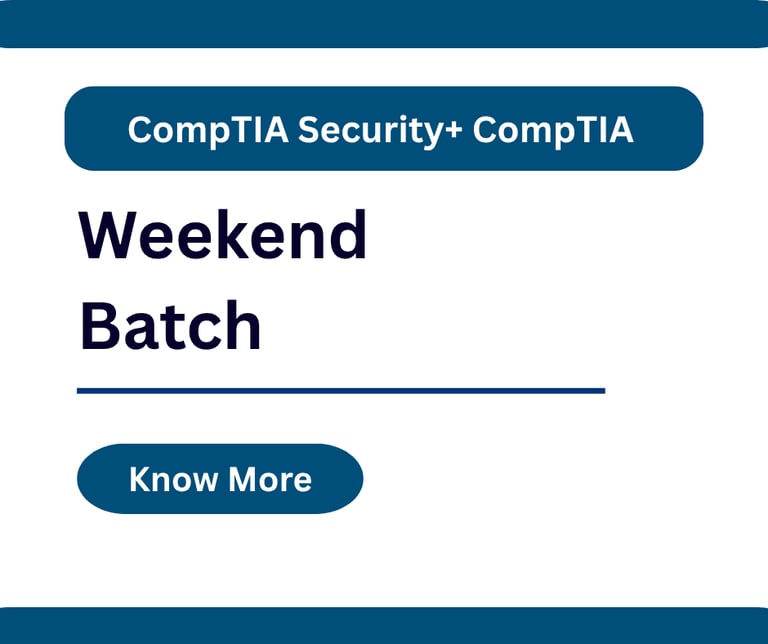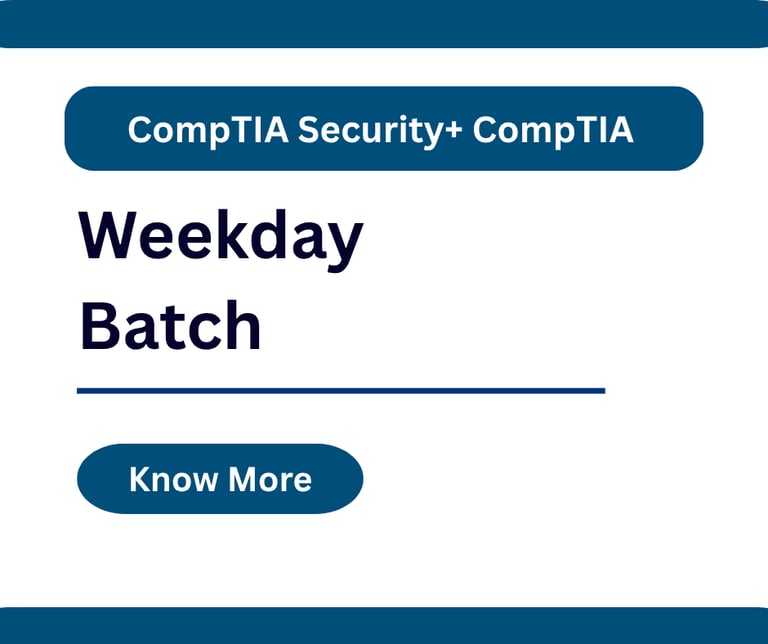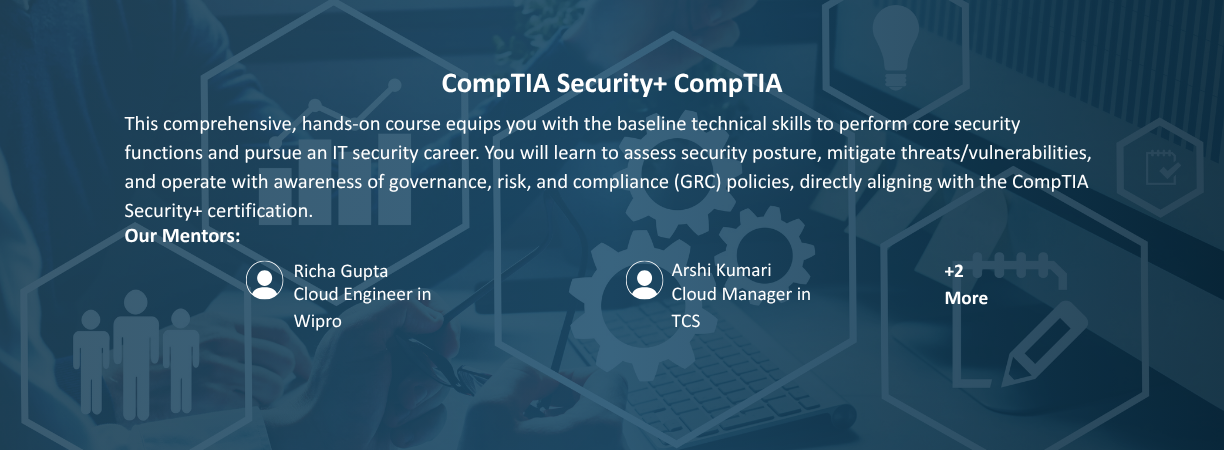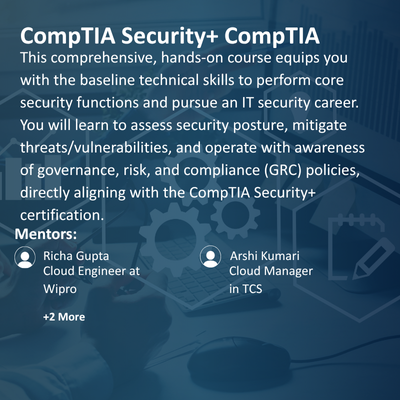







Major Industry Recruiters








Major Industry Recruiters
Course Description:
This comprehensive, hands-on course equips you with the baseline technical skills to perform core security functions and pursue a career in IT security. You will learn to assess the security posture of an enterprise environment, identify and mitigate threats and vulnerabilities, and operate with an awareness of applicable governance, risk, and compliance (GRC) policies. The course is directly aligned with the CompTIA Security+ certification objectives, preparing you to become a trusted defender of digital environments.
Course Objective:
The primary objective of this course is to prepare students to successfully pass the CompTIA Security+ certification exam and establish a foundational career in IT security.
Upon completion of this course, students will be able to:
Assess and Mitigate Threats: Analyze common threats, vulnerabilities, and malicious attacks against enterprise environments and apply effective mitigation and security controls.
Implement Secure Architectures: Design and deploy security across network devices, cloud environments, and host systems, utilizing secure protocols and defense-in-depth principles.
Configure Identity and Access Management (IAM): Implement authentication, authorization, and accounting (AAA), manage user access, and apply cryptographic techniques and PKI for data protection.
Execute Security Operations: Apply operational procedures, including vulnerability management, monitoring (SIEM), and following the incident response process.
Apply GRC Principles: Operate with a critical understanding of governance, risk management, and compliance (GRC) policies, regulations, and business continuity concepts.
Course Module:
The course content is structured around the primary domains tested by the CompTIA Security+ exam, reflecting the real-world responsibilities of a security professional.
1. Threats, Vulnerabilities, and Mitigations
Malicious Activity: Analyzing common threat actors, their motivations, and the types of attacks they execute (e.g., malware, social engineering, password attacks).
Vulnerability Assessment: Identifying system weaknesses, performing vulnerability scans, and understanding security assessment tools and techniques (e.g., penetration testing concepts).
Mitigation: Applying security controls and techniques to prevent and recover from attacks (e.g., patching, segmentation, hardening).
2. Security Architecture and Design
Secure Systems: Applying security principles to enterprise infrastructure, including cloud, hybrid, mobile, and IoT environments.
Network Security: Implementing secure network designs, secure protocols (e.g., VPNs, TLS), and security devices (e.g., firewalls, IDS/IPS).
Data Protection: Understanding data types, classifications, and methods for securing data at rest, in transit, and in use (e.g., encryption, DLP).
3. Implementation and Technologies
Identity and Access Management (IAM): Implementing authentication, authorization, and accounting (AAA) concepts, multi-factor authentication (MFA), and access control models.
Cryptography and PKI: Explaining cryptographic concepts, algorithms, hashing, and the role of Public Key Infrastructure (PKI) for secure communications and digital signatures.
Secure Configuration: Applying secure baselines, securing hosts (servers/clients) and applications, and configuring wireless security.
4. Security Operations and Incident Response
Operational Security: Implementing security baselines, monitoring system logs (SIEM), and managing security within the context of hardware, software, and data asset lifecycles.
Vulnerability Management: The processes of identification, analysis, remediation, and reporting of vulnerabilities.
Incident Response: Applying the incident response process (preparation, detection, analysis, containment, eradication, and recovery) and utilizing digital forensics data sources.
5. Governance, Risk, and Compliance (GRC)
Risk Management: Explaining risk assessment, analysis, mitigation strategies, and the importance of Business Impact Analysis (BIA) and business continuity planning.
Policies and Procedures: Understanding security policies, standards, procedures, and guidelines (e.g., Acceptable Use Policy).
Compliance: Summarizing the impact of regulations and standards (e.g., GDPR, HIPAA) on an organization's security posture.
Course Overview:
The CompTIA Security+ certification is a globally recognized, vendor-neutral credential that validates the knowledge and skills necessary to secure and troubleshoot systems and networks. The curriculum is structured around the primary domains tested by the certification exam.

Upcoming Batches: Choose as per Your Requirement




Our Mentors:
Richa Gupta
Cloud Engineer in Wipro
Arshi Kumari
Cloud Manager in TCS
Ahmed Khan
Cloud Engineer in Cognizant
Abhishek Singh
Cloud Engineer in IBM
Our Mentors:
Richa Gupta
Cloud Engineer in Wipro
Aina Rathor
DevOps Engineerex-Deloitte
Ahmed Khan
Coud Engineer in Cognizant
Coud Engineer in IBM
Abhishek Singh
Our Alumni Work at Top Companies
FAQs – CompTIA Security+ CompTIA at GIMIT
1) What is the CompTIA Security+ certification?
It is a globally recognized, vendor-neutral certification that validates the foundational knowledge and skills required for core security functions and entry-level cybersecurity careers.
2) What is the current exam code for the Security+ certification?
The current exam code is SY0-601.
3) What job roles typically require or benefit from Security+?
Roles include Security Administrator, Security Specialist, Security Consultant, Junior Cybersecurity Analyst, and other IT roles that handle security operations.
4) What are the key knowledge domains covered by the exam?
The exam covers Threats, Vulnerabilities, and Mitigations; Security Architecture and Design; Implementation; Security Operations; and Governance, Risk, and Compliance (GRC).
5) Does the Security+ exam include any hands-on elements?
Yes, the exam includes Performance-Based Items (PBIs), which simulate real-world scenarios requiring hands-on problem-solving, in addition to multiple-choice questions.
6) What are the recommended prerequisites for taking the Security+ exam?
CompTIA recommends having the Network+ certification and two years of experience in IT administration with a security focus, though neither is mandatory.
7) How long is the Security+ certification valid?
The certification is valid for three years.
8) How can I renew my Security+ certification?
You can renew through CompTIA's Continuing Education (CE) program by earning 50 CE units within the three-year period, often by completing higher-level certifications or training.
9) What should I focus on regarding attacks and threats for the exam?
Focus on analyzing attacks like malware, social engineering, and denial-of-service (DoS), and understanding how to identify and mitigate system vulnerabilities.
10) What does GRC stand for, and what part does it play in the Security+ curriculum?
GRC stands for Governance, Risk, and Compliance. It covers the policies, risk management strategies, and regulatory frameworks (like HIPAA or GDPR) that govern security in an organization.





